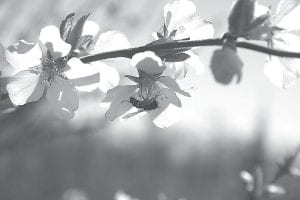The Minnesota Department of Agriculture recently published a new Pollinator Report. The report addresses concerns over the decline in pollinating insects such as the honey bee which began in 2007. It was created in response to 2013 legislation requiring the department to work toward creating proposals, processes and criteria to enhance pollinator habitat as well as review certain pesticides thought to possibly be a detriment to pollinating insects. The report was created in collaboration with the Minnesota Department of Transportation, the Minnesota Department of Natural Resources, the Minnesota Pollution Control Agency, and the University of Minnesota among others. It ascribes the decline in pollinator population to many factors ranging from parasites and pesticides, to loss of habitat and fewer beekeepers.
Although pollinators include some animals such as certain birds and bats, 99 percent of all pollination is attributable to insects. Bees are considered to be the most efficient and important of all pollinators of our food crops. Thirty-five percent of all global food volume comes from plants that to some extent depend on animal/insect pollination. The majority of pollination for agricultural crops in the U.S. is done by the honey bee (Apis mellifera). The annual value of their pollination is estimated at $15-18 billion. Another $3 billion in value is attributable to native bees. Honey bees visit approximately 2 million flowers to make 1 pound of honey and the average hive requires over 75 pounds of honey to survive a Minnesota winter. There are approximately 2.6 million managed honey bee hives in the U.S.
Minnesota is consistently among the top few honey producing states in the U.S. Together with Montana, North and South Dakota, Wisconsin, and Michigan they comprise 5 percent of U.S. honey production.
Many state and federal programs such as Roadsides for Wildlife, Reinvest in Minnesota and the Minnesota Prairie Conservation Plan already support pollinators by establishing and protecting habitat. However, the report states that the effectiveness of such plans is still largely unknown due to gaps in general knowledge about many pollinating insects and their habitat needs. For example, some plant species such as yellow and white sweet clover that have been a traditional resource for honey bees are now considered invasive species by some agencies and alternative floral sources need to be found.
The report includes a proposal to create a “Pollinator Bank,” which would be used to develop specific data on individual pollinators as well as areas where individual species could be preserved.
Also included is a proposal for a special review of the effects of neonicotinoid insecticides on pollinators to be completed between 2016 and 2018. Neonicotinoid insecticides are the most widely used insecticides in the world and comprise about 25 percent of the global agrochemical market. They work as an insecticide by affecting the nerves and causing paralysis and death in insects coming in contact with them. They generally are used as a seed treatment and are readily absorbed throughout the entire plant to protect it. Because they are effective at very low concentrations they are less toxic to birds and mammals.
Local beekeeper Mark Ditmanson explained how Cook County beekeepers are in a somewhat unique situation. Most of the Cook County honey bees were originally brought in from the Thunder Bay area when parasites such as mites were not yet proliferating. That has now changed and Ditmanson says that some of the local beekeepers feel that we should propagate our own bees and avoid bringing in others from the outside. Also, Cook County is not a large agricultural area so pesticide concerns are not troubling as they may be elsewhere. These differences help to keep the Cook County honey bee population stronger and healthier than some other places. The habitat issues of a boreal forest versus an intensive agricultural area also create a twist. Ditmanson believes his bees and the local flora both benefit from each other and said, “We’d like to think that the flowers around us are a little brighter.”
To learn more, view the report on pollinators on the MDA website at: http://www.mda.state.mn.us/en/protecting/bmps/pollinators.aspx



Loading Comments